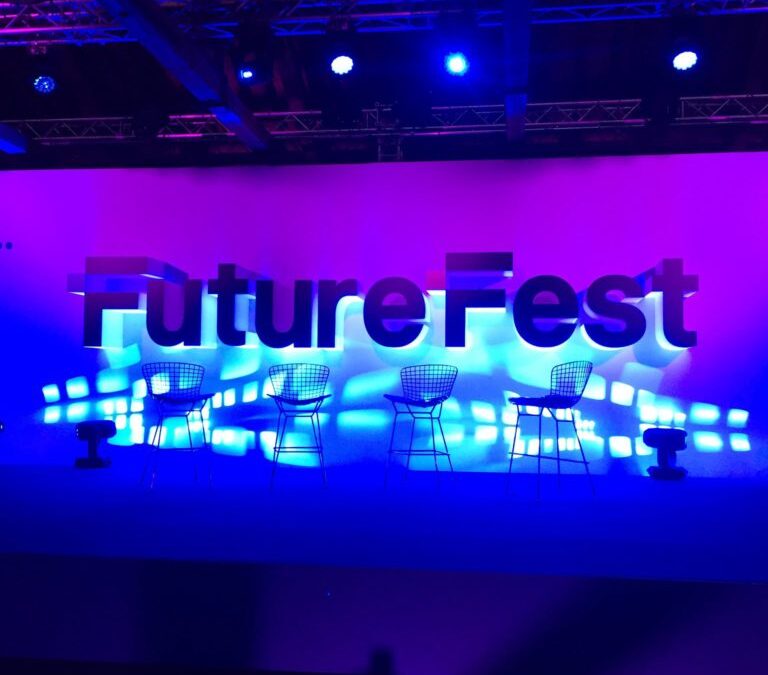
by Lisa Devaney | 19 Sep, 2016 | Announcement
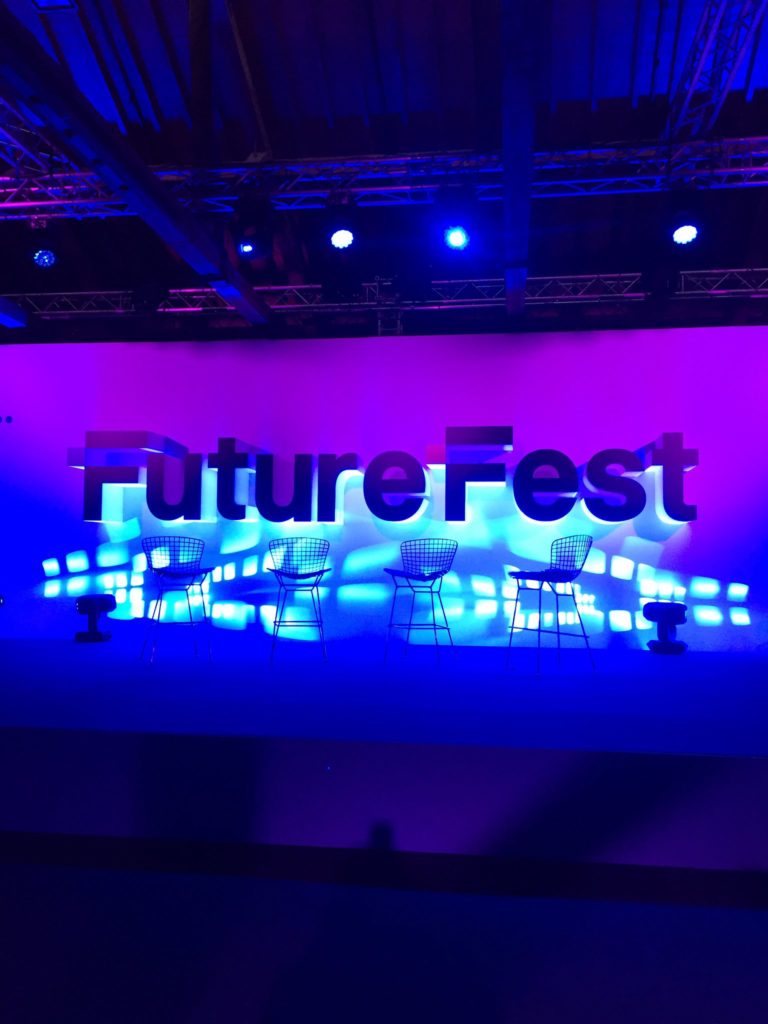
In 30 years time, the very essence of who we are may shift in directions we can only imagine right now – every visceral emotion and human need from what we eat to how we express love for each other and how we interact with machines is all changing. These far-reaching ideas, and many more, which aren’t just science fiction fantasies, were demonstrated and explored over two days (September 17-18) for innovation foundation Nesta’s FutureFest 2016.
The third year of FutureFest attracted 4,000 people to Tobacco Dock in London and turned the venue into a playground of possibility. Talks from Brian Eno, DJ Spooky, Will Self, Sherry Coutu CBE, Mustafa Suleyman, Ghislaine Boddington (also a curator of Future Love happenings), Ruth Amos, Claire Lomas, Laurie Penny, Anjali Ramachandran, Kate Russell, Pat Kane (who curated the Futre Play programme), Cindy Gallop, Es Devlin, Bill Burnett, Dr. Trudy Barber, Rhyannon Styles and many, many more fascinating speakers, took place, along with a mix of digital art and performances.
What was most striking is the exploration of the absolute most basic of human existence with discussions on how we will all love, play, work and thrive taking centre stage in conversations. While big questions of politics (Caroline Lucas MP with the Green Party participated in this discussion about where things are headed politically), how we’ll use data, combat disease, consider gender identity, and more, were bantered about among the guest experts, their on-stage conversations inspired attendants to tackle monstrous ideas, and debate between themselves about the positive and negative consequences future life may bring.
Some may have found these beyond-the-now explorations a little bit creepy, such as taking a visit to the Love After Death exhibit, where 15 minute conversations with counsellors helped people chart a course for extending your presence, digitally, after you die and discussing how you want your body to be treated post-death. Also for thought exploration was a fertility exhibit about the pros and cons, and questions and concerns, of egg freezing. These topics may make some squeamish or uncomfortable, but are all good for thought provocation, and important, for thinking about future scenarios.
In fact, it is letting your brain tackle sometimes unnerving concepts that leads to amazing innovation, such as was demonstrated in the Cybathlon exhibit where examples of assistive technology and robotics showed how futuristic technology is helping people with disabilities become mobile again. Or, when cyber-athlete Claire Lomas walked onto the stage in a fully robotic exoskeleton. Bravo! This is where the future gets so exciting, and promising.

Cyber-athlete Claire Lomas walks on stage at FutureFest 2016 in exoskeleton. *Photo courtesy of FutureFest
Kicking things off at FutureFest on the Saturday morning, in the mission to push your thinking into new boundaries, was Hannes Sjoblad (a biohacking and human augmentation activist) who led a “Implant Party” on stage by having two volunteers get computer chips inserted into their hands. The chips allow them to interact with digital devices, such as finding lost keys or activating other technologies.
Among the high energy speaker presentations were appearances by Cindy Gallop (an influential woman in the advertising business and founder of IfWeRanTheWorld and MakeLoveNotPorn) who challenged work place structures and gender roles with commentary in sessions that set the room on fire, such as proclaiming “You will never own the future if you care what other people think!” and living up to her reputation of blowing things up, as “the Michael Bay of business”.
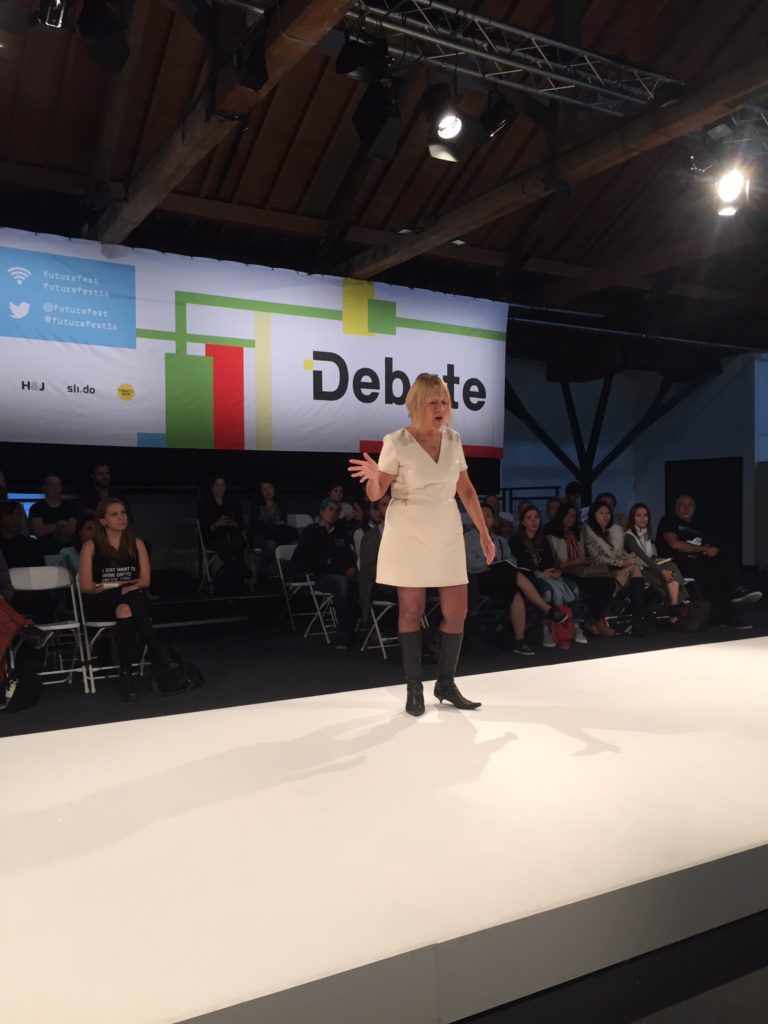
Cindy Gallop on the Debate stage at FutureFest 2016
Headlining FutureFest was Brian Eno who discussed the importance of play in learning, and criticized traditional education for turning the process into something that becomes un-fun, when A-Level exams take place. Also a popular speaker was super smart DJ Spooky who offered some interesting insight into how music and technology wrap around the theme of love.
When the futuristic ideas all filled your head to overload, there were plenty of calming places to retreat to, especially the beautiful Collective Reality (an installation by body>data>space), where you could dance and move with others in a space of swirling visuals, or perch on a comfortable bean bag chair and watch professional dancers perform. Or, relax outside the venue and enjoy street food while looking at an old ship docked in the canal.

Dancer Eliza DeLite in Collective Reality at FutureFest 2016
So what does 2030 hold? It is fantastic that Nesta and all the involved partners and organizers and curators provided a place to unleash what is a smorgasbord of inspiring ideas for the future. Much discussed is so far ahead from our known existence today, that it is difficult to visualize the reality, but unless we all think about it, and act toward positive, well-calibrated, outcomes –progress will never happen.
Like they say in Star Trek, FutureFest encourages us “to boldly go where no man (or woman!) has gone before.”
FutureFest 2016 was supported by innovation partner Nissan and the University of Greenwich, Oxford Martin School at the University of Oxford, D3 Technologies and EUNIC London.
The two-day event takes place every 18 months and details can be found at: futurefest.org
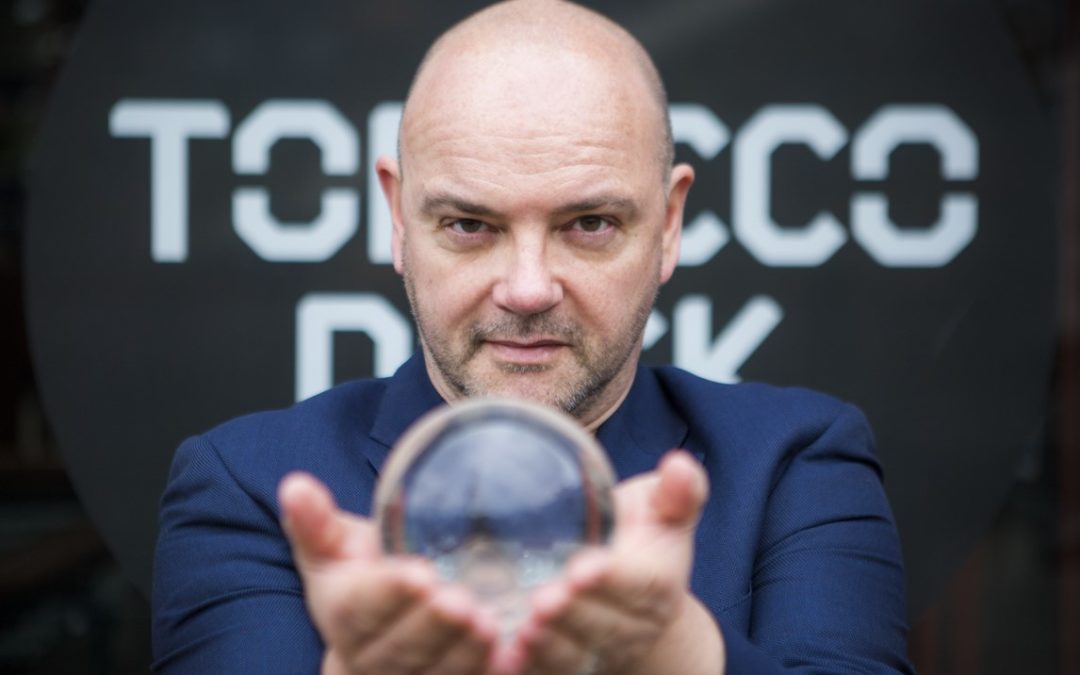
by Lisa Devaney | 12 Sep, 2016 | Announcement
Twenty years into the future, how we love, work, play and thrive may change drastically, and be enhanced and entwined with technology,
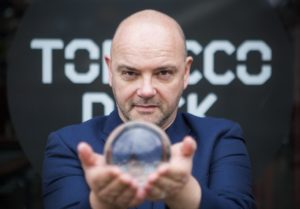
Pat Kane, FutureFest 2016 curator
future thinkers and leaders will discuss at the annual FutureFest, brought to London by Nesta. The event takes place this weekend (September 17-18) and promises to deliver a mind-opening collection of talks, debates and immersive experiences that will get you contemplating far ahead to what’s in store for humanity, and how individuals can alter and influence the course of things to come.
The line-up this year includes music pioneers Brian Eno and DJ Spooky, writing pioneer Will Self, and AI pioneer Mustafa Suleyman – the co-founder of Google DeepMind. Attendants will also hear from must-see radicals like Cindy Gallop, the entrepreneur actively shaking up the workplace gender debate, and Claire Lomas, the cyber-athlete who completed the London Marathon in an exoskeleton. Others on the bill include the Green Party’s Caroline Lucas, MP, and journalists Kate Russell and Bill Thompson and body technologist Ghislaine Boddington.
While visions of the future may be utopian or dystopian, many attending FutureFest will enjoy using their imaginations to explore both scenarios, along with the science that can offer concrete insights of how we are progressing. Research released ahead of FutureFest by Nesta reports that 60% of people in the UK think that technology will improve their future wellbeing. European neighbours, however, revealed more pessimism toward future tech, with French people believing it will lead to unemployment and Spaniards expressing concern it will lead to a breakdown of trust. More details about the research findings are here.
One topic sure to be of interest is how we will love in the future, with Ghislaine Boddington (see her thoughts on this topic here) sharing how we can think toward the most universal of all emotions, exploring what happens to romance, dating, identity and even skin when we move beyond the physical and merge with the virtual, by inviting pioneers, innovators and future thinkers to share their visions. More about the Future Love programme schedule for FutureFest can be found here.
FutureFest happens at The Dock, Tobacco Quay, London. Social media fans can follow the discussion with the hashtag #FutureFest16. Tickets are available from £25 (students) up to £80 for the weekend.
Hai Media Group will be in attendance, live tweeting as talks and debates happen from our Twitter (@HaiMediaGroup) and Instagram (@HaiMediaGroup) channels.

FutureFest 2016: Food for your brain
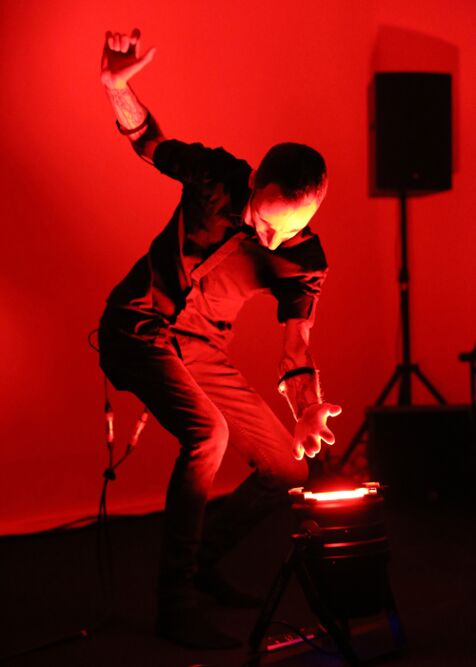
by Lisa Devaney | 6 Jul, 2016 | Announcement
On our radar this week is a new exhibition opening for Summer 2016. Check out:
The Games Europe Plays – BODY<>TECH
The Stephen Lawrence Gallery at the University of Greenwich
7 July – 26 August 2016

Marco Donnarumma (Italy)
Here’s more more about the exhibition from the press release:
Exploring our body from its hidden micro bacteria to its digital incarnations, The Games Europe Plays – BODY<>TECH takes a playful look at how digital technologies are helping us to heal but can also disturb our wellbeing. Presenting the works of interactive artists and game makers from the UK and continental Europe, the show envisions how we will inhabit and take care of our virtual and physical bodies in the future.
Join us this summer in Greenwich to meet A.I. (artificially insane) avatars, enter the whole genome sequenc-ing of bacteria in virtual reality and rebalance yourself through play.
Go on a journey where your body, mind and senses will be guided and confounded. Are you ready to explore the uncanny valley?
With: Anna Dumitriu with Alex May (UK), Ivor Diosi (Czech Republic), Marco Donnarumma (Italy), Blast The-ory (UK), Designwarm (UK) and Grendel Games (Netherlands)
In ‘Molding the Signifier’ by Ivor Diosi you’ll meet 3 chatty avatars who get infected by a mysterious bacteria slowly disrupting their conversation and behaviour. Anna Dumitriu with Alex May turn Staphylococcus aureus bacteria collected on her body into an installation and a virtual reality experience. Marco Donnarumma uses his heart beats, blood stream and muscle contractions to create digital music and media. The beautiful Good Night Lamp by Designwarm uses the Internet of Things technology to tell a loved one ‘I’m thinking of you’ at a distance. Blast Theory’s app Karen (UK) is a life coach who gets a little bit too friendly and intrusive. If you feel a bit disturbed after all these experiences, Dutch game ‘Songs of Elstryn’ will invite to rebalance yourself physically and mentally.
The exhibition is the second in a series of three shows initiated by EUNIC London and curated by body tech-nologist and digital expert Ghislaine Boddington (Creative Director, body>data>space / Reader CPDA Uni-versity of Greenwich). They bring to the UK the best independent and innovative games and digital experi-ences made in Europe with a strong emphasis on design, virtual interactivity and physical engagement.
‘BODY<>TECH engages in a debate in Europe around gaming and interactive works that represent our bod-ies and minds. Showing projects both with social purpose and artistic intents the works in this exhibition dis-play a way of being in a new world – where the inside moves outside, the digital helps the physical, virtual and physical intimacies merge. The Games Europe Plays – BODY<>TECH reflects on potential digital physical “bodies” of the future’ Ghislaine Boddington.
The Games Europe Plays is a EUNIC London project, produced by the Finnish Institute and body>data>space. Initiated by the Czech Centre, the project is supported by British Council and Arts Council England. It is presented at the Stephen Lawrence Gallery and supported by the University of Greenwich (Department of Creative Professions & Digital Art), in association with Nesta’s FutureFest and London Games Festival. With additional support from the Czech Centre, the Italian Cultural Institute and the Em-bassy of the Netherlands.
- Press View: Wednesday 6 July at 4pm, please rsvp to Marie Proffit: marie@bodydataspace.net
- Opening: Wednesday 6 July at 6.30pm, please rsvp to a.e.craft@gre.ac.uk
- Colloquium: Join us on Thursday 7 July from 11am to 4pm at the University of Greenwich (SE10 9BD) for a day of colloquium with curator Ghislaine Boddington and Digital Arts Lead Ian Thompson, associated art-ists and experts.
The Games Europe Plays – BODY<>TECH
The Stephen Lawrence Gallery / University of Greenwich / 10 Stockwell St, London SE10 9BD
The exhibition is open to the public from 7 July – 26 August 2016: Tuesday-Friday: 11am-5pm
Saturday: 11am-4pm. Tweet us at #GamesEU
http://europe.org.uk/event/the-games-europe-plays-body-tech/
Note to editors
The Games Europe Plays
In 2016 ‘The Games Europe Plays’ brings to the UK audience a selection of independent and innovative games and interactive experiences made in Europe. Kicking off at the Finnish Institute in London April 2016 as part of London Games Festival, it will now show at the Stephen Lawrence Gallery at the Uni-versity of Greenwich in July/August and culminate in September 2016 as an exhibition as part of FutureFest (Nesta). ‘The Games Europe Plays’ is a series of exhibitions and events inviting developers and experts from continental Europe and the UK to meet and debate with UK audience and professionals. http://europe.org.uk/project/the-games-europe-play/
EUNIC London
EUNIC London (European Union National Institutes for Culture) is the network of the cultural institutes and embassies from the member states of the European Union in London. A branch of EUNIC Global, the Lon-don network was established in 2007 and has at present 32 members who share knowledge and re-sources in order to promote greater cooperation and develop partnerships between European nations and UK organisations. EUNIC London is a proud initiator, organiser and supporter of creative projects highlight-ing Europe’s fantastic diversity in arts, culture and language. The Finnish Institute, British Council, Czech Centre and all involved institutes in TGEP are members of ENIC London. http://europe.org.uk
Finnish Institute in London
The Finnish Institute in London is a private, non-profit trust bringing together individuals, communities and organisations. Our mission is to identify emerging issues important to contemporary society in Finland, the United Kingdom and the Republic of Ireland. We encourage cross-disciplinary and cross-border collaboration by creating networks and building new partnerships. We work with artists, creatives, academics and policy-makers. http://www.finnish-institute.org.uk
Ghislaine Boddington
Co-founder and Creative Director of body>data>space and Women Shift Digital, is a curator, presenter and thought leader specialising in body responsive technologies, Ghislaine is recognised as an international pio-neer advocating the use of the entire body as a digital interaction canvas for over 25 years. A co-creator and director of many art works exploring the hyper enhancement of our human senses through the digital and a lead director of international multi-partner projects, she is co-curator of FutureFest 2016 – a festival of ideas hosted by Nesta, innovation foundation – and is a Reader in the Department of Creative Professions and Digital Art at the University of Greenwich. http://www.bodydataspace.net
The British Council
British Council is the UK’s international cultural relations organisation. Arts is a cornerstone of the British Council’s mission to create a friendly knowledge and understanding between the people of the UK and the wider world. We find new ways of connecting with and understanding each other through the arts, to develop stronger creative sectors around the world that are better connected with the UK. https://www.britishcouncil.org/arts
Stephen Lawrence Gallery / The University of Greenwich
University of Greenwich Galleries was set up in 2013 to manage the expansion in gallery provision resulting from the development of the new academic building in Stockwell Street. The Stephen Lawrence Gallery was founded in 2000 on the initiative of the then Dean, Paul Stigant, working in close partnership with Stephen’s mother, Doreen Lawrence, who had been a student at the University in 1993 when her son was murdered in a racist attack. The gallery aims to promote diversity in the representation of visual cultures through mainly curated group exhibitions featuring the work of young contemporary visual practitioners from a wide range of disciplines, including artists, designers, and architects. http://www.greenwichunigalleries.co.uk

Blast Theory’s app Karen
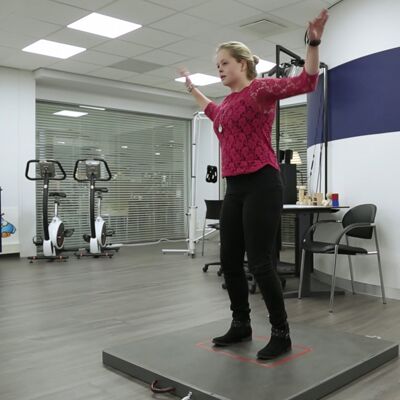
Grendel Games

by Lisa Devaney | 5 May, 2016 | Announcement
In an interview with Eric Dye, host of the Entrepreneur Podcast Network, of Enterprise Radio, our Founder and Director Lisa Devaney shared some tips about tech startup public relations.
In the interview, she talked about planning carefully before you start talking in public, among other great advice:
Don’t over promise…remember that Google sticks! Be really careful about what you are saying publically. It burns your credibility to not deliver what you are promising.
Really build your own visibility online before visiting the media with your story.
Be sure to speak in clear, jargon-free terms when describing your business.
You can listen to the full interview here:
http://epodcastnetwork.com/talking-tech-startup-pr-with-lisa-devaney-of-hai-media-group

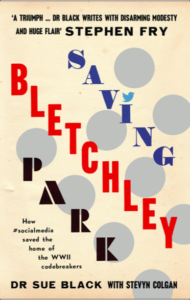
by Lisa Devaney | 25 Apr, 2016 | News
This story was first published by our Founder and Director Lisa Devaney with Brand Republic’s The Wall Blog UK, and you can find it here, or read below:
So often these days, news headlines are pock-marked with nasty tales of hacking incidents, online trolling, bullying and abuse that are setting a lot of people off from participating with any social media platform. But now and then, examples of how fantastic, caring and beneficial social media can be comes into public awareness and forces us to not ignore the good of this medium for all.

Saving Bletchley Park
In a new book Saving Bletchley Park written by Dr Sue Black OBE (@Dr_Black), with help from Stevyn Colgan, a fascinating story is told about how Twitter, and the power of digital and social media, strengthened and was instrumental in saving a near derelict World War II codebreakers headquarters at Bletchley Park. Recently released, and funded fully through a crowdfunding campaign orchestrated by the publishing company Unbound, the book is already a bestseller on Amazon.
If you are looking for that ray of sunshine in your social media case studies, or just want a positive example to explain to colleagues about how social media can work, this is a must read. I marvelled that it is a tale where old technology is saved by new technology, where modern Twitter, and other social channels, play a crucial role in helping preserve the place where modern computing took root, being the birthplace of Colossus and the work base of Alan Turing, who was key in cracking the codes generated by the Enigma machine.
In the book, the author shares so much about the step-by-step evolution of this valiant and dedicated effort of her, and colleagues, years of work to make sure it was not eradicated physically from the UK’s places of historic interest. Hundreds of people sought to preserve Bletchley Park over 20 years. It is likely that many in the UK, and beyond, will know that Bletchley Park is credited for having brought World War II to an end, two years earlier than expected, and to have saved an estimated 22 million lives with the top secret work of codebreaking. Nearly 10,000 people worked in cloaked roles, many being women, and all signed and sworn to a strict secrets act preventing them from speaking about their labour at the place. Sir Winston Churchill said of the codebreakers that they were “the geese that laid the golden egg and never cackled.”
What many may be surprised to learn is how decayed and near demise the site of this crucial turning point for the war was facing not long ago, until its rescuers became activists for the historic venue’s survival. What Dr. Black’s book reveals is a combination of historic information, human anecdotes, and a really good case study for how social media can flip a forgotten relic into public consciousness, over time.
Along the way, Dr Black, using Twitter, along with blogging and other social media channels, found that the digital generation’s freely available tools could help her make people care, and do something to save Bletchley Park. In her tale, you’ll read about how some of the UK’s popular Twitter aficionados like Christian Payne (@documentally), Jamillah Knowles (@jemimah_knight), Mike Sizemore (@sizemore), the Tuttle Club, and more, played a role in raising awareness for the Bletchley Park cause. So much so, that the effort won the attention of celebrity Stephen Fry and, also attracted support and attention from various members of the Royal family, and executives from Google.
Sure, social media wasn’t the only contributing factor, but, as you will find out in the book, it was a major catalyst and turning point for the campaign. The book includes Dr. Black’s tips and real-life, reality based, proven approaches to using social media, and her own journey from intrepidation and low confidence with the medium, to being a fearless advocate of its powers.
As Dr Black describes in this passage from her book:
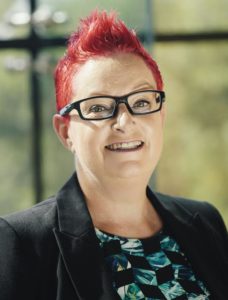
Dr Sue Black OBE, photo by ali Tollervey
“Social media has allowed me to be myself, the me that was always there inside but a bit scared to come out. I grew up a shy person, scared to voice my opinions in case I offended someone. Over the years, I’ve forced myself to speak when something needs changing. Social media has shown me that there are many people out there that feel the same way I do and that it’s fine to say what I think in public. It’s a simple lesson, but having grown up a girl in the 1960s and ‘70s, it’s diametrically opposed to what I grew up being told. “Don’t speak until you are spoken to” was a frequently used phrase in my upbringing, something I have in common with a whole generation of girls. I’m so glad that women are finally finding their voice. It may cause some change that will be difficult for society as a whole to deal with, but in the long run it will benefit us all.”














